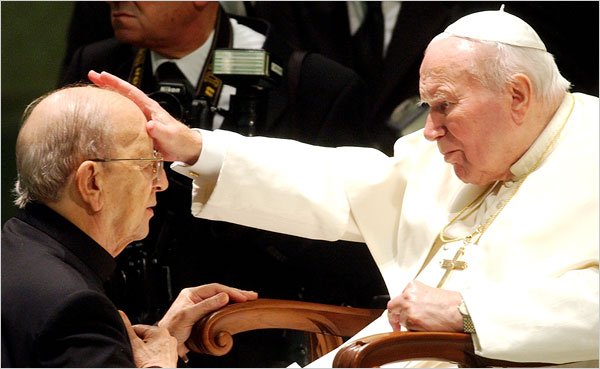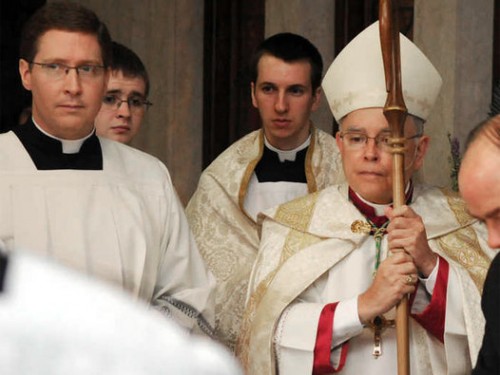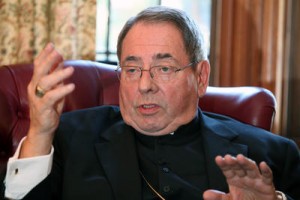The best part of this news is: if this man can make it to heaven, no one else has anything to worry about.
by Barbie Latza Nadeau

On May 1, 2011, the late pope John Paul II was beatified as a precursor to sainthood after being credited for miraculously curing a French nun of Parkinson’s disease. On that day, the family of a severely ill Costa Rican woman reportedly prayed to the beatified pontiff for her recovery. According to Costa Rican daily La Nación, the sick woman had visited the Calerdon Guardia hospital in San José just days before John Paul was beatified and was diagnosed with an aneurysm on a major blood vessel in her brain. After the beautification and the family’s prayers, the aneurysm miraculously disappeared, according to Alejandro Vargas Roman, the attending physician in an interview with La Nación. Because there was no logical medical explanation and plenty of proof of the prayers to the pontiff, the miracle was chalked up to the divine intercession of the late John Paul II. It was then submitted to the Congregation for the Causes of Saints, along with scores of others, to be considered as his second miracle, which is necessary for attaining sainthood.
This week, after a thorough review, the congregation approved a yet unnamed miracle in which they say John Paul II was responsible for the “inexplicable recovery” of a gravely ill person. On Friday, before Pope Francis officially signed off on the second miracle, rumors hinted that it supposedly took place in Costa Rica. In fact, the Costa Rican woman’s doctor has confirmed that he submitted paperwork to the Congregation reviewing the miracles. Whatever it was, the second miracle now paved the way for John Paul II to become a saint, which will likely be celebrated in a canonization ceremony later this year, possibly on December 8, which is a major Catholic feast day and national holiday in Italy. He will likely be canonized together with John XXIII, another favored pope that Pope Francis decided to beatify without proof of miracles.
In deciding the validity of miracles, the Congregation for the Causes of Saints must consider reams of testimony, including lengthy reports from medical doctors and technicians who must eliminate beyond a reasonable doubt any medical explanation for the recovery. In the case of John Paul II’s first miracle, Monsignor Slawomir Oder, who was then postulator of the cause for that miracle, told The Daily Beast that thousands of cases were presented for consideration as miracles by people in Brazil, Colombia, Italy, Mexico, Poland, Spain, and the United States, but the most compelling was the case of the French nun, Sister Marie Simon-Pierre, who was diagnosed with Parkinson’s disease in 2001 when she was just 40 years old. She was miraculously cured of the disease on June 2, 2005, after a night of prayer to the Polish pontiff, who had died two months earlier. “Since then I have not taken any treatment. My life has completely changed—it was like a second birth for me,” she said at the time her miracle was accepted by the Congregation for the Causes of Saints. Sister Simon-Pierre suffered what seemed to be a brief relapse just as preparations were being finalized for John Paul II’s beautification, but it turned out to be a false alarm. She was the keynote speaker at the beatification ceremony, which drew more than 1 million pilgrims to Rome. “What the Lord has granted me through the intercession of John Paul II is a great mystery difficult to explain with words— something very great and profound— but nothing is impossible for God,” she told those gathered for the celebratory event.
Miracles are by their nature not easy to prove, and the Congregation for the Causes of Saints does not take its work lightly. There are more than 30 monsignors, bishops, and archbishops who shoulder the theological weight of validating miracles, including ascertaining proof that the cured patient spent sufficient time in honest prayer to the would-be saint. But there are also more than 80 consultants, including medical doctors, technicians, psychiatrists, and even hand-writing analysts who investigate every aspect of the miracle in search of a secular explanation. Sister Simon-Pierre underwent extensive psychological testing to vet her belief in John Paul II, and her Mother Superior and sisters in her convent were quizzed about her faith. Doctor Franco Di Rosa sat on the Vatican’s miracle board for more than 25 years as a medical consultant. He described to The Daily Beast how the process works, and how the person who claims a miracle must be thoroughly investigated: “He or she must go to their bishop who then charges outside specialists with verifying that the treatments were ineffective,” he says. “He or she must also go many years without a relapse.”
The postulator of the miracle, who acts as a caretaker to shepherd the miracle process through a labyrinth of bureaucratic red tape, then prepares an extensive dossier including medical records, X-rays, and medication history to substantiate whether conventional treatment may have aided the cure. Two doctors then review the case before sending it to a committee of five medical experts who must all agree that there is no explanation for the reversal of the disease other than divine intervention. “In 99 percent of the cases, we find a medical explanation,” he says. “In the rare cases we don’t, the panel of theologians then steps in to make a final recommendation to the pope.”
In the case of John Paul II, some naysayers have said that his promotion to sainthood has been fast-tracked to ride the wave of the pope’s enduring popularity during troubling times at the Vatican with a barrage of sex and financial scandals. When John Paul II died in 2005, pilgrims held signs and chanted “santo subito,” or “sainthood now,” at his funeral. Pope Benedict XVI sped things up for his predecessor by waiving the standard five-year waiting period between death and beatification for John Paul II to facilitate the process that allowed the late pope’s cause to reach the brink of sainthood so soon.
Whatever the reason, canonizing John Paul II will easily be one of the most important feel-good events in the church’s history. More than a million followers came to Rome for the beatification, and many more are expected when he escalates to sainthood. And that might be just the miracle the troubled church is looking for.
Complete Article HERE!





